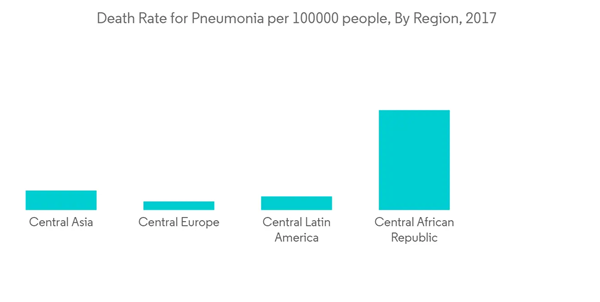Pneumonia testing market is growing at good rate as pneumonia is a life-threatening disease wherein testing helps the people to know in advance and further, they can be cured quickly. The major factor attributing to the growth of the market are rise in adoption of POC testing and development in the field of nucleic acid detection. Moreover, the awareness level is increasing day by day which results in early diagnosis, hence promoting the growth of pneumonia testing market.
In addition, pneumonia is found to be the major cause of death in children. For instance, in 2018 according to UNICEF, about 800000 children died due to pneumonia. Also, these diseases are more prevalent in South Asia and African countries. However, due to the limited detection capability and accuracy, the market is expected to be hampered to a certain extent.
Pneumonia Testing Market Trends
Point of Care Testing Segment is Expected to Contribute Major Market Share in the Pneumonia Testing Market
- POC testing is a revolutionary technology which is currently an ideal technique for detecting pneumonia. The growing adoption of POC testing is attributed to higher efficiency, increasing cases of pneumonia and the rapid test results due to which it is highly preferable.
- Therefore with the high prevalence of chronic diseases in large customer base adopting the cost-effective and immediate diagnostic tests, is propelling the point of care testing. The advantages of POC test to render rapid and accurate results helps in promoting the patient-centred healthcare at bedside settings which further result in the adoption of point of care testing and thereby promoting the growth of pneumonia testing market.
North America is Expected to Hold a Significant Share in the Market and Expected to do Same in the Forecast Period
North America is expected to hold a major market share in the global Pneumonia Testing due to increasing geriatric population region. For instance, according to Centers for Disease Control and Prevention pneumonia is an eighth leading cause for mortality in the United States which further lead to increased awareness about the disease and further drive the pneumonia testing market.There are also rising product approval and increasing product launches that are driving the overall market in this region. For instance, BioMérieux has received FDA Clearance for BioFire's FilmArray Respiratory Panel 2 (RP2). Furthermore, with the increasing healthcare expenditure and the presence of well-established healthcare infrastructure is also fueling the growth of the overall regional market to a large extent.
Pneumonia Testing Industry Overview
Pneumonia Testing Market is fragmented competitive and consists of several major players. In terms of market share, few of the major players are currently dominating the market. Some of the companies which are currently dominating the market are Abbott, Bio-Rad Laboratories, Inc., bioMerieux SA, Thermo Fisher Scientific, Hologic, Inc, Meridian Bioscience, Quidel Corporation, BD and Curetis.Additional Benefits:
- The market estimate (ME) sheet in Excel format
- 3 months of analyst support
This product will be delivered within 2 business days.









